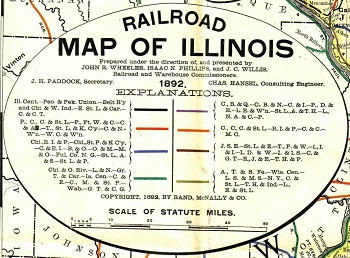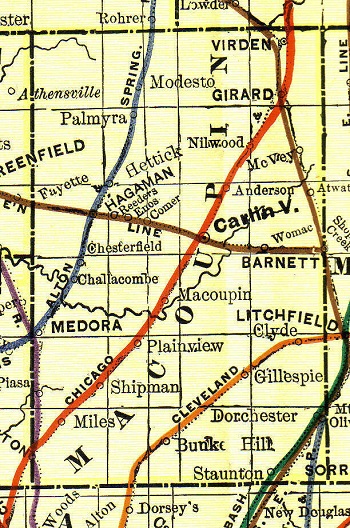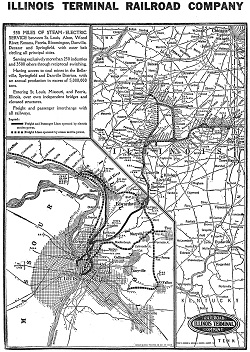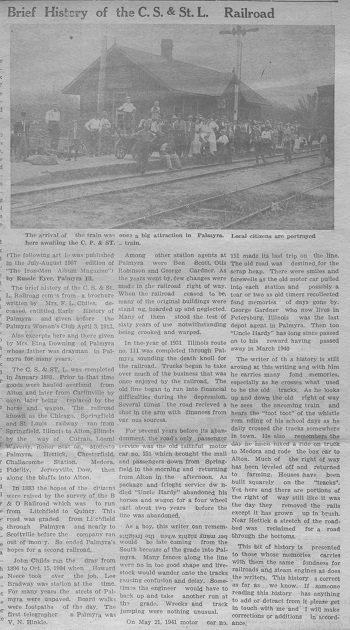

 There
was no explanation in the book about the many railroad lines
for one color line. Bob Mosher believes that the reason for more than
one railroad line for each railroad color may be that the lines probably
had contractual agreements; in some cases they were local feeder lines
that ONLY fed into a main line, in others they appear to be trunk lines
that continue a route.
There
was no explanation in the book about the many railroad lines
for one color line. Bob Mosher believes that the reason for more than
one railroad line for each railroad color may be that the lines probably
had contractual agreements; in some cases they were local feeder lines
that ONLY fed into a main line, in others they appear to be trunk lines
that continue a route.
Legend with the abbreviations written out. Most towns on the railroad lines in Macoupin in 1892 had a coal mine in them.
Black Line
Ill Cent - Illinois
Central Railroad Company
Peo & Pek Union - Peoria & Pekin Union
Railway Company
Belt R’y and Chi W Ind - Belt Railway of Chicago &
Chicago & Western Indiana Railroad Company
E St L & Car - East St.
Louis & Carondelet Railway Company
C & C T - Chicago & Calument
Terminal Railway Company
Red Line
P, C, C & St L -
Pittsburgh, Cincinnati, Chicago & St. Louis Railway Company
P, Ft W &
C - Pittsburgh, Fort Wayne & Chicago Railway Company
C & Alt -
Chicago & Alton Railroad Company
T, St L & K C’y - Toledo, St. Louis
& Kansas City Railroad Company
C & N W’n - Chicago & Northwestern
Railway Company
W C & W’n – Wabash, Chester & Western Railroad
Company
Blue Line
Chi, R I & P – Chicago, Rock Island &
Pacific Railway Company
Chi, St P & K C’y – Chicago, St. Paul &
Kansas City Railway Company
C & E I – Chicago & Eastern Illinois
Railroad Company
B & O – Baltimore & Ohio Railroad Company
O & M –
Ohio & Mississippi Railway Company
M & O – Mobile & Ohio Railroad
Company
Ful Co N G – Fulton County Narrow Gauge Railway Company
St
L, A & S – St. Louis, Alton & Springfield Railroad Company
St L & P –
St. Louis & Peoria Railroad Company
Green Line
Chi & O Riv –
Chicago & Ohio River Railroad Company
L & N – Louisville & Nashville
Railroad Company
Gr T & Car – Grand Tower & Carbondale Railroad
Company
Ia Cen – Iowa Central Railway Company
C & E – Chicago &
Erie Railroad Company
C, M & St P – Chicago, Milwaukee & St. Paul
Railway Company
Wab – Wabash Railroad Company
G T & C G – Grand
Tower & Cape Girardeau Railroad Company
Purple Line
C, B & Q
– Chicago, Burlington & Quincy Railroad Company
C, B & N – Chicago,
Burlington & Northern Railroad Company
C & I – Chicago & Iowa
Railroad Company
P, D & E – Peoria, Decatur & Evansville Railway
Company
L E & W’n – Lake Erie & Western Railroad Company
St L, A &
T H – St. Louis, Alton & Terre Haute Railroad Company
L, N A & C P –
Louisville, New Albany & Chicago Railroad Company??
Orange Line
C, C, C & St L – Cleveland, Cincinnati, Chicago & St. Louis Railway
Company
R I & P – Rock Island & Peoria Railway Company
C & C –
Centralia & Chester Railroad Company
M C – Michigan Central Railroad
Company
Brown Line
J S E – ??
St L & E – St. Louis &
Eastern Railway Company
T, P & W – Toledo, Peoria & Western Railway
Company
I, I & I – Indiana, Illinois & Iowa Railroad Company
I, D
& W – Indiana, Decatur & Western Railroad Company
I & I S – Indiana &
Illinois Southern Railroad Company
C & G T – Chicago & Grand Trunk
Railway Company
E, J & E – Elgin, Joliet & Eastern Railway Company
T H & P – Terre Haute & Peoria Railroad Company
Olive Line
A,
T & S Fe – Atchison, Topeka & Santa Fe Railroad Company
Wis Cen –
Wisconsin Central Line
L S & M S – Lake Shore & Michigan Southern
Railway Company
N Y, C & St L – New York, Chicago & St. Louis
Railroad Company
T H & Ind – Terre Haute & Indianapolis
L, E & St
L – Louisville, Evansville & St. Louis Consolidated Railroad Company
Several railroads enter and cross Macoupin
county. The Chicago & Alton enters the county on section 4, in Virden
township and traverses the county in a southwestern direction, leaving it at
Brighton, on section 19. The most important stations are
Carlinville, Girard, Nilwood, Shipman and Brighton. In 1852 the road was
completed between Alton and Springfield and in 1864 trains were running
to East St. Louis. Later, the road entered the city of St. Louis.
The
Cleveland, Cincinnati, Chicago & St. Louis has for its main stations in
the county, Bunker Hill, Dorchester and Gillespie; the Wabash, Staunton and
Mt. Olive; The Jacksonville & St. Louis, Virden and Girard; St. Louis,
Rock Island & Chicago, Brighton and Medora; Quincy, Carrollton & St. Louis,
Carlinville ; Chicago, Peoria & St. Louis, Medora, Hettick, Modesto and
Chesterfield; Litchfield & Madison, Mt. Olive and Staunton; Illinois Central, Mt. Olive;
Macoupin County, under management of the Chicago & Northwestern,
Sawyerville and Benld; St. Louis, Springfield & Peoria, Staunton, Mt.
Olive, Sawyerville, Benld, Gillespie,
Carlinville, Nilwood, Girard and Virden; Chicago & Eastern Illinois,
track at Staunton. Most of these roads are coal feeders to other lines.
Extracted from History of Macoupin County, by Charles A. Walker,
published in 1911, volume 1, page 307.
 The Illinois Terminal
Railroad Company (IT), known as the Illinois Traction System until 1937, was a
heavy duty interurban electric railroad with extensive passenger and freight
business.
The Illinois Terminal
Railroad Company (IT), known as the Illinois Traction System until 1937, was a
heavy duty interurban electric railroad with extensive passenger and freight
business.
 The
brief history of the C. S. & St. L. Railroad comes from a brochure written by
Mrs. F. L. Chiles, deceased, entitled Early History of Palmyra and given before
the Palmyra Woman's Club April 3, 1913.
The
brief history of the C. S. & St. L. Railroad comes from a brochure written by
Mrs. F. L. Chiles, deceased, entitled Early History of Palmyra and given before
the Palmyra Woman's Club April 3, 1913.
Also excerpts here and there
given by Mrs. Etna Downing of Palmyra whose father was drayman in Palmyra for
many years.
The C. S. & St. L. was completed in January 1881. Prior to
that time goods were hauled overland from Alton and later from Carlinville by
oxen, later being replaced by the horse and wagon. The railroad known as the
Chicago, Springfield and St. Louis railway ran from Springfield, Illinois to
Alton, Illinois by the way of Curran, Loami, Waverly, Roher Station, Modesto,
Palmyra, Hettick, Chesterfield, Challacombe Station, Medora, Fidelity,
Jerseyville, Dow, then along the bluffs into Alton.
In 1883 the hopes of
the citizens were raised by the survey of the B & O Railroad which was to run
from Litchfield to Quincy. This road was graded from Litchfield through Palmyra
and nearly to Scottville before the company ran out of money. So ended Palmyra's
hopes for a second railroad.
John Childs ran the dray from 1894 to Oct.
15, 1904 when Howard Neece took over the job. Lee Bradway was station at the
time. For many years the streets of Palmyra were unpaved. Board walks were
footpaths of the day. The first telegrapher in Palmyra was V. N Hinkle.
Among other station agents at Palmyra were Ben Scott, Otis Robinson and George
Gardner. As the years went by, few changes were made in the railroad right of
way. When the railroad ceased to be, many of the original buildings were
standing, boarded up and neglected. Many of them stood the test of sixty years
of use notwithstanding being crooked and warped.
In the year of 1931
Illinois route no. 111 was completed through Palmyra sounding the death knoll
for the railroad. Trucks began to take over much of the business that was once
enjoyed by the railroad. The old line began to run into financial difficulties
during the depression. Several times the road received a shot in the arm with
finances from various sources.
For several years before its abandonment,
the road's only passenger service was the old faithful motor car no. 151 which
brought the mail and passengers down from Springfield in the morning and
returning from Alton in the afternoon. As package and freight service dwindled
"Uncle Hardy" abandoned his horses and wagon for a four wheel cart about two
years before the line was abandoned.
As a boy, this writer can remember
many nights when the freights would be late coming from the South because of the
grade into Palmyra. Many fences along the line were not in too good shape and
livestock would wander onto the tracks causing confusion and delay. Sometimes
the engineer would have to back up and take another run at the grade. Wrecks and
track jumping were nothing unusual.
On May 21, 1941 motor car no. 151
made its last trip on the line. The old road was destined for the scrap heap.
There were smiles and farewells as the old motor car pulled into each station
and possibly a tear or two as old timers recollected fond memories of days gone
by. George Gardner who now lives in Petersburg, Illinois, was the last depot
agent in Palmyra. Then too "Uncle Hardy" has long since passed on to his reward
having passed away in March 1940.
The writer of this history is still
around at this writing and with him he carries many fond memories, especially as
he crosses what used to be the old tracks. As he looks up and down the old right
of way, he sees the oncoming train and hears the "toot toot" of the whistle
reminding of his school days as he daily crossed the tracks somewhere in town.
He also remembers the day he hitchhiked a ride on truck to Medora and rode the
box car to Alton. Much of the right of way has been leveled off and returned to
farming. Houses have been built squarely on the "Tracks." Yet here and there are
portions of the right of way still like it was the day they removed the rails
except it has grown up in brush. Near Hettick a stretch of the roadbed was
reclaimed for a road through the bottoms.